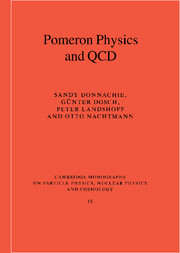Book contents
- Frontmatter
- Contents
- Preface
- 1 Properties of the S-matrix
- 2 Regge poles
- 3 Introduction to soft hadronic processes
- 4 Duality
- 5 Photon-induced processes
- 6 QCD: perturbative and nonperturbative
- 7 Hard processes
- 8 Soft diffraction and vacuum structure
- 9 The dipole approach
- 10 Questions for the future
- Appendix A Sommerfeld-Watson transform
- Appendix B The group SU(3)
- Appendix C Feynman rules of QCD
- Appendix D Pion-nucleon amplitudes
- Appendix E The density matrix of vector mesons
- References
- Index
10 - Questions for the future
Published online by Cambridge University Press: 19 August 2009
- Frontmatter
- Contents
- Preface
- 1 Properties of the S-matrix
- 2 Regge poles
- 3 Introduction to soft hadronic processes
- 4 Duality
- 5 Photon-induced processes
- 6 QCD: perturbative and nonperturbative
- 7 Hard processes
- 8 Soft diffraction and vacuum structure
- 9 The dipole approach
- 10 Questions for the future
- Appendix A Sommerfeld-Watson transform
- Appendix B The group SU(3)
- Appendix C Feynman rules of QCD
- Appendix D Pion-nucleon amplitudes
- Appendix E The density matrix of vector mesons
- References
- Index
Summary
The experimental and theoretical study of diffractive phenomena has been very fruitful over the last two decades. With the ongoing experiments at HERA, the Tevatron and RHIC, and the start-up of the LHC, this field of research will remain of high topical interest. It is clear that the description of diffractive phenomena through QCD is rather complicated. Thus, what can we hope to learn by studying diffractive phenomena? For testing the basic principles of QCD in experiment and for determining the fundamental parameters of QCD we should choose simple reactions where perturbation theory is without doubt applicable. In the nonperturbative domain we should choose quantities which can be calculated reliably on the lattice. Diffractive phenomena are unlikely to be of direct benefit here, until theorists make significant progress with their calculational methods. Diffraction can be considered as an area for “applied QCD”, where theorists have been developing various approximation schemes in order to understand the observed phenomena. For this a continual interplay of experiment and theory has been essential, and in the future will still be so. It has been the experimental possibility of studying diffractive phenomena under conditions very different from elastic hadron-hadron scattering which has brought diffractive phenomena to the fore and stimulated so much theoretical development. In this final chapter we review briefly the outstanding issues.
Regge theory, introduced more than forty years ago, remains remarkably successful in providing a phenomenological description of soft high-energy hadronic and photon-induced processes.
- Type
- Chapter
- Information
- Pomeron Physics and QCD , pp. 295 - 300Publisher: Cambridge University PressPrint publication year: 2002

